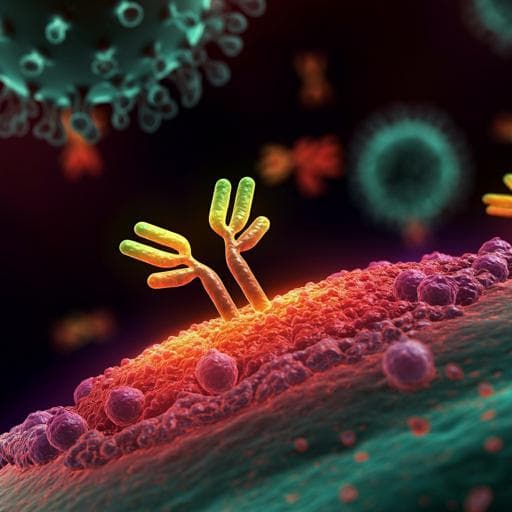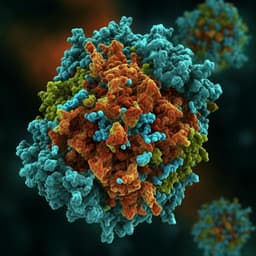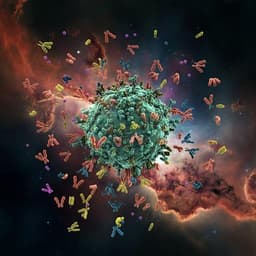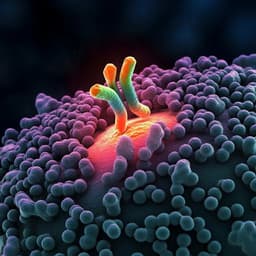
Medicine and Health
An ancestral SARS-CoV-2 vaccine induces anti-Omicron variants antibodies by hypermutation
S. Park, J. Choi, et al.
This research conducted by Seoryeong Park, Jaewon Choi, and others explores how the Omicron variant-neutralizing antibodies evolve following booster vaccinations with the BNT162b2 vaccine. With an exciting discovery of somatic hypermutation leading to a broad immune response, the study reveals a potential protective mechanism against viral escape.
~3 min • Beginner • English
Introduction
Since the emergence of SARS-CoV-2, extensive genomic surveillance has identified many viral variants. The spike protein—especially its receptor-binding domain (RBD)—is the primary target of neutralizing antibodies and a key component of current vaccines. Omicron RBD harbors numerous mutations that markedly reduce neutralization after two doses of BNT162b2. Although bivalent vaccines were developed, most individuals received monovalent ancestral spike vaccines. Notably, a third monovalent BNT162b2 dose restores detectable neutralization against Omicron BA.1 and has been associated with increased somatic hypermutation (SHM) in virus-specific antibodies. The study aims to clarify how repeated exposure to the ancestral spike drives the development of antibodies that neutralize Omicron variants, by longitudinally analyzing BCR repertoires and characterizing RBD-reactive clonotypes.
Literature Review
Prior work established that the RBD accounts for approximately 90% of neutralizing activity in immune sera and is central to mRNA, adenoviral, and recombinant protein vaccines. Omicron RBD mutations led to ~22-fold reductions in neutralization after two BNT162b2 doses. Booster (third) doses of the monovalent mRNA vaccine restored neutralizing activity against BA.1 and increased SHM in antigen-specific B cells. Reports also documented frequent usage of IGHV3-33/IGHV3-66 with IGHJ6 in SARS-CoV-2 neutralizing antibodies, indicating stereotyped public responses. Yet, the mechanistic basis by which booster vaccination with ancestral spike elicits Omicron-reactive antibodies—whether via selection and maturation of specific clonotypes and SHM-driven breadth—remained to be fully delineated.
Methodology
- Study design and participants: 41 healthcare workers at Seoul National University Hospital received two BNT162b2 doses 3 weeks apart and a third dose at ~9 months after the first dose. Blood was collected at six time points: pre-vaccination; 1 week after dose 1; 1, 6, and 30 weeks after dose 2; and 1–4 weeks after dose 3. Participants reported no COVID-19 history and were negative for anti-nucleocapsid IgG.
- Serology: ELISAs measured plasma IgA/IgG against ancestral and Omicron RBDs (including BA.1 and BQ.1). Plates were coated with recombinant RBDs, blocked, incubated with serially diluted plasma or phage supernatant, and detected with HRP-conjugated secondary antibodies and TMB substrate. EC50 values were calculated with GraphPad Prism.
- BCR repertoire sequencing: Peripheral blood mononuclear cells were processed to generate cDNA; V_H and V_L regions were amplified and sequenced on Illumina NovaSeq 6000. Read processing used PEAR for merging, q20 filtering, primer trimming, UMI-based clustering/subclustering, Clustal Omega for alignment, and consensus calling. IgBlast (v1.17.1) annotated IGHV/D/J usage and SHM counts. SHMs were quantified relative to IGHV germline within primer-amplified regions. Quality filters removed short reads, nonproductive sequences, and those lacking V(D)J or isotype annotations.
- scFv phage display libraries: From six selected vaccinees (Nos. 22, 27, 32, 35, 39, 43), scFv libraries were constructed using V_H and V_L amplified from the sixth time point RNA. Libraries underwent five rounds of biopanning against BA.1 RBD, and individual binders were identified by phage ELISA and Sanger sequencing. Selected scFvs were expressed as scFv-hFc-HA fusion proteins in mammalian cells and purified.
- HCDR3 randomization: For selected clonotypes (e.g., 27–60), libraries with randomized HCDR3 were generated by overlap-extension PCR and cloned into phagemids for selection.
- Functional characterization: Recombinant scFv-hFc-HA proteins pairing BCR heavy chains from identified clonotypes with defined light chains were tested by ELISA against ancestral and Omicron RBDs (BA.1, BA.2, BA.4, BA.5, BQ.1.1, XBB.1.5, XBB.1.16). EC50 values were determined.
- Microneutralization assay: Authentic SARS-CoV-2 isolates (ancestral, Beta, Gamma, Delta, Omicron BA.1) were propagated in Vero cells. Neutralization was assessed by preincubating virus with recombinant proteins, infecting Vero cells, and quantifying cytopathic effect; IC50s were computed via dose–response fitting.
- Clonotype definition and tracking: BCR heavy-chain clonotypes were defined by IGHV/IGHJ gene usage and ≥80% HCDR3 amino-acid identity to a reference sequence. Frequencies, isotype distributions, SHM levels, and diversity metrics were compared across time points, with emphasis on the third and sixth repertoires due to expansion after boosting.
Key Findings
- Humoral response dynamics: Plasma IgA/IgG against ancestral RBD rose significantly after the second dose. Robust IgA/IgG responses to BA.1 RBD required the third dose, with cross-reactivity observed to BQ.1.
- BA.1-RBD-reactive BCR expansion after boost: Among 293 BA.1-RBD-reactive BCR sequences, 57 and 216 were detected in the third and sixth repertoires, respectively, indicating marked clonal expansion following the third dose.
- Isotype and diversity changes: Rapid class-switch recombination to IgG (and IgG2) was observed by the third time point and maintained at the sixth. BCR sequence diversity increased from the third to the sixth repertoire.
- Somatic hypermutation accumulation: SHM levels increased significantly from the third to the sixth time point among BA.1-RBD-reactive clonotypes. This was evident in multiple vaccinees, including those carrying the 27–60 (IGHV3-33/3-66, IGHJ6) and 43–34 clonotypes.
- Clonotype 27–60 functional maturation: Back-mutation analyses showed that specific SHMs (e.g., V27 in CDR1 and F56 adjacent to CDR2) were critical for affinity to ancestral and BA.1 RBDs; reverting these reduced affinity (ancestral: ~8.7-fold decrease; BA.1: affinity greatly diminished). All sixth-repertoire 27–60 heavy chains acquired a V97 mutation associated with increased ancestral RBD affinity.
- Affinity gains with boosting: For the ancestral RBD, six scFvs from the third repertoire exhibited EC50 < 7.5 nM. Only one showed comparable BA.1 binding at that time. In the sixth repertoire, four additional scFvs acquired high BA.1 affinity (EC50 < 4.5 nM).
- Other clonotypes (35-15, 35-46, 43-09, 43-34): Sixth-repertoire heavy chains showed more SHMs than their third-repertoire counterparts. All sixth-repertoire scFvs demonstrated strong ancestral RBD binding (EC50 < 200 pM), with paired sequences maintaining similar potency (≤2-fold difference). For certain pairs, affinity improvements were substantial, e.g., apparent EC50 improvements from 0.59, 1.12, and 7.91 nM (third) to 0.13, 0.09, and 0.14 nM (sixth), respectively.
- Breadth to Omicron subvariants: SHM-driven diversification expanded reactivity to BA.1 and further to BQ.1.1, XBB.1.5, and XBB.1.16 within clonotype lineages, indicating acquisition of cross-variant binding breadth after the third dose.
- Public antibody features: The IGHV3-33/3-66 with IGHJ6 pairing (e.g., 27–60) recurred across multiple vaccinees and is consistent with previously reported public neutralizing responses to SARS-CoV-2 RBD.
- Overall: The third BNT162b2 dose promoted SHM accumulation in a limited set of clonotypes, enhancing affinity to ancestral RBD while conferring de novo or improved affinity to Omicron RBDs, thereby broadening antibody specificity.
Discussion
The findings indicate that repeated exposure to the ancestral spike via a third BNT162b2 dose drives affinity maturation within specific public and private BCR clonotypes. Accumulating somatic hypermutations—particularly in IGHV3-33/3-66, IGHJ6 (27–60) and other recurrent clonotypes—enhanced binding to ancestral RBD and, crucially, conferred or improved recognition of Omicron RBDs and subvariants. This maturation was accompanied by class switching to IgG and increased repertoire diversity. The data support a model in which booster vaccination leverages germinal center maturation to broaden the specificity of existing memory B cells, counteracting antigenic drift and immune escape. Such SHM-mediated expansion of the BCR recognition space likely underlies restored plasma neutralization against Omicron variants after boosting and may endow resilience against future variants with related epitope landscapes.
Conclusion
This study demonstrates that a third dose of an ancestral SARS-CoV-2 mRNA vaccine promotes extensive SHM and diversification within a limited number of BCR clonotypes, yielding antibodies with enhanced affinity to the ancestral RBD and newly acquired or improved reactivity to Omicron (including BQ.1.1 and XBB lineages). Public clonotypes (e.g., IGHV3-33/3-66 with IGHJ6) play a central role in this broadened response. These results highlight SHM-driven breadth as a protective mechanism against variant immune escape.
Future research should assess durability of these SHM-enriched clonotypes, map structural bases of broadened specificity, evaluate functional neutralization breadth against emergent variants in vivo, and explore vaccine designs or boosting intervals that further promote beneficial maturation pathways.
Limitations
- Skewed clonotype expansion after the third dose led the authors to limit statistical analyses to BCR heavy-chain sequences present in the third and sixth repertoires, potentially constraining temporal resolution at intermediate points.
- SHM quantification was restricted to primer-amplified IGHV regions; mutations outside primer binding sites could not be assessed, possibly underestimating total mutational load.
- Only six vaccinees were selected for scFv phage display library construction and detailed functional characterization, which may limit generalizability of clonotype-level functional findings across the full cohort.
- The study primarily measured binding (ELISA EC50) to RBDs of multiple variants; while microneutralization methods were described, comprehensive neutralization results against all subvariants are not detailed in the provided text.
- The authors note that limitations exist but believe they minimally affect the interpretations and conclusions.
Related Publications
Explore these studies to deepen your understanding of the subject.







